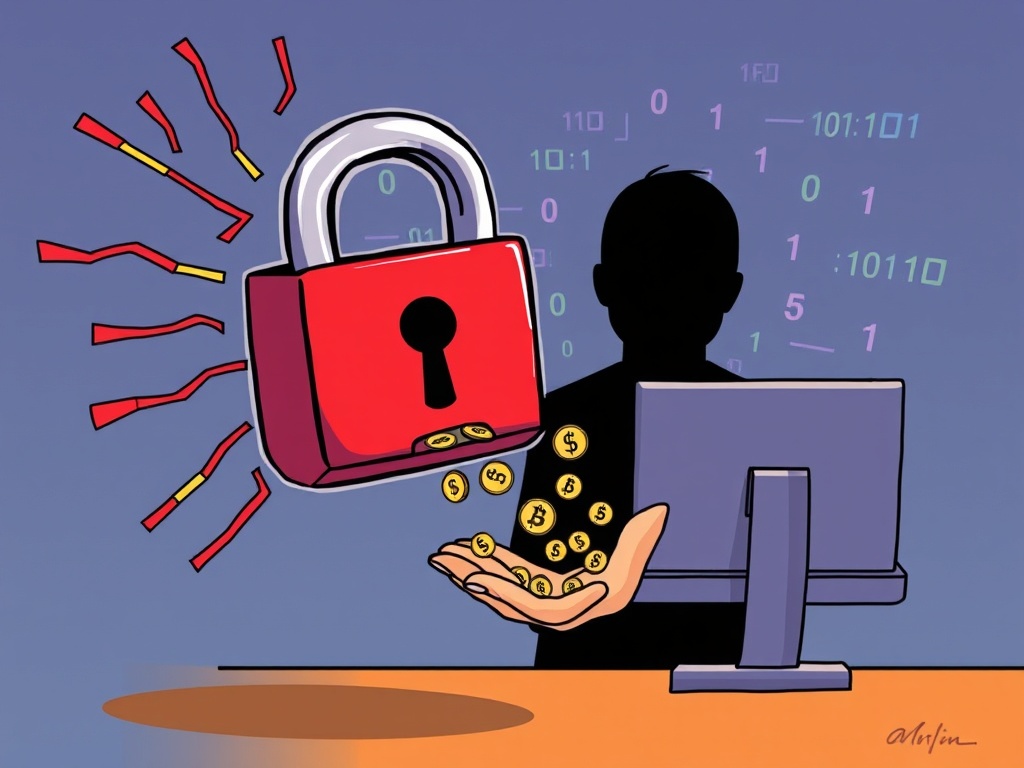BitcoinWorld

CoinDCX Hack: Alarming Truth Unveiled in $44 Million Crypto Heist
The cryptocurrency world is once again buzzing with news that underscores the critical importance of robust security. A recent development involving the Indian crypto exchange CoinDCX has sent ripples across the industry, highlighting the ever-present threat of internal vulnerabilities and sophisticated cybercrime. This incident, often referred to as the CoinDCX hack, brings to light the alleged involvement of an employee in a significant breach that saw a staggering $44 million siphoned away.
What Exactly Happened in the CoinDCX Hack Allegations?
Reports from BeInCrypto detail the arrest of Rahul Agarwal, a software engineer working at CoinDCX. He stands accused of playing a pivotal role in facilitating a massive $44 million breach. Authorities suspect that Agarwal’s internal credentials were exploited, or perhaps directly used, to gain unauthorized access to CoinDCX’s systems. This access allegedly allowed the perpetrators to divert a substantial sum of digital assets into six distinct cryptocurrency wallets. While Agarwal vehemently denies the allegations, the investigation is ongoing, painting a complex picture of a potential inside job or a highly sophisticated social engineering attack.
This incident isn’t just about a large sum of money; it’s about trust and the intricate layers of security that crypto exchanges are expected to maintain. The alleged CoinDCX hack raises uncomfortable questions about:
- The vetting processes for employees with high-level system access.
- The efficacy of internal monitoring and audit trails.
- The potential for insider threats, whether intentional or accidental.
Why Are Credential Security and Social Engineering So Dangerous for Crypto Exchanges?
The alleged methods behind the CoinDCX hack point directly to two major vulnerabilities: compromised credentials and social engineering. These aren’t new threats, but their impact on the high-value, fast-moving world of cryptocurrency can be catastrophic.
Understanding the Threats:
- Credential Compromise: This occurs when an attacker gains access to legitimate login information (usernames, passwords, API keys). This could happen through phishing, malware, brute-force attacks, or even internal negligence. Once credentials are stolen, the attacker can impersonate a legitimate user, bypassing many standard security measures.
- Social Engineering: This involves manipulating individuals into divulging confidential information or performing actions they wouldn’t normally do. Techniques include phishing emails, pretexting (creating a fabricated scenario), baiting, and quid pro quo. For instance, an employee might be tricked into clicking a malicious link, revealing their login details, or even granting access to internal systems.
In the context of a major crypto exchange, an insider with system access, even if their credentials are ‘borrowed’ through social engineering, presents a unique and formidable challenge. They often have an inherent level of trust and access that external hackers lack, making detection and prevention significantly harder. The alleged CoinDCX hack serves as a stark reminder of this critical vulnerability.
What Are the Broader Implications of Incidents Like the CoinDCX Hack for the Crypto Industry?
Every major security breach, especially one of the scale of the alleged CoinDCX hack, sends reverberations throughout the entire cryptocurrency ecosystem. It erodes public trust, invites greater regulatory scrutiny, and forces exchanges to continually re-evaluate and fortify their defenses.
Key Implications:
| Implication | Description |
|---|---|
| Erosion of Trust | Each hack, whether internal or external, makes potential new users hesitant to enter the crypto space and existing users question the safety of their funds on centralized exchanges. |
| Increased Regulatory Scrutiny | Governments and financial bodies worldwide are already looking closely at crypto. Incidents like the alleged CoinDCX hack provide further impetus for stricter regulations, potentially impacting innovation and accessibility. |
| Enhanced Security Measures | Exchanges are compelled to invest more heavily in advanced security protocols, including multi-factor authentication (MFA), cold storage solutions, rigorous internal audits, and comprehensive employee training programs. |
| Focus on Decentralization | Breaches at centralized entities often reignite debates about the inherent security advantages of decentralized finance (DeFi) protocols, where user funds are typically held in non-custodial wallets. |
The industry must learn from these incidents, not just from a technical standpoint but also from an operational and human perspective. Building a resilient and trustworthy crypto environment requires continuous adaptation and proactive measures against all forms of threats.
How Can Users Protect Themselves After Learning About the CoinDCX Hack?
While exchanges bear the primary responsibility for securing user funds, individual users also play a crucial role in safeguarding their digital assets. The alleged CoinDCX hack serves as a powerful reminder that vigilance is paramount. Here are actionable insights to enhance your personal crypto security:
- Enable Two-Factor Authentication (2FA) Everywhere: This is your first line of defense. Use strong 2FA methods like authenticator apps (e.g., Google Authenticator, Authy) rather than SMS-based 2FA, which can be vulnerable to SIM-swapping attacks.
- Use Strong, Unique Passwords: Never reuse passwords across different platforms. Use a reputable password manager to generate and store complex, unique passwords for each of your crypto accounts.
- Be Wary of Phishing Attempts: Always double-check the URL of any exchange or wallet website. Be suspicious of unsolicited emails, messages, or calls asking for your personal information or login credentials. Scammers often mimic legitimate entities.
- Understand Cold Storage: For significant holdings, consider moving your cryptocurrencies to a hardware wallet (cold storage). This keeps your private keys offline, making them much harder for hackers to access.
- Regularly Monitor Your Accounts: Keep an eye on your transaction history and account balances. Report any suspicious activity to your exchange immediately.
- Research Exchange Security: Before choosing an exchange, research their security practices. Do they have insurance? Do they conduct regular security audits? What percentage of funds do they keep in cold storage?
Your active participation in security measures is just as vital as the security protocols implemented by the exchanges themselves. Stay informed, stay vigilant.
What Steps Are Exchanges Taking to Prevent Another CoinDCX Hack Scenario?
The crypto industry is constantly evolving, and so are the threats it faces. Following incidents like the alleged CoinDCX hack, exchanges are compelled to enhance their security frameworks significantly. This involves a multi-faceted approach addressing both external and internal vulnerabilities.
Proactive Measures by Exchanges:
- Enhanced Internal Controls: Implementing stricter access controls, principle of least privilege, and regular audits of employee activities. This includes monitoring for unusual login patterns or data access.
- Robust Employee Vetting & Training: Conducting thorough background checks for employees, especially those with access to sensitive systems. Regular cybersecurity training for all staff, focusing on social engineering awareness and secure coding practices.
- Advanced Threat Detection Systems: Deploying AI-powered anomaly detection, intrusion detection systems (IDS), and security information and event management (SIEM) tools to identify suspicious activities in real-time.
- Bug Bounty Programs: Encouraging ethical hackers to find and report vulnerabilities in their systems, offering rewards for discovered flaws before malicious actors can exploit them.
- Insurance and Reserve Funds: Many exchanges maintain insurance policies or dedicated reserve funds to compensate users in the event of a security breach, although the specifics vary.
- Regular Security Audits & Penetration Testing: Engaging third-party cybersecurity firms to conduct independent security audits and penetration tests to identify weaknesses.
While no system can be 100% impervious to attack, these ongoing efforts are crucial in building a more secure and resilient infrastructure for digital assets. The goal is to make incidents like the alleged CoinDCX hack increasingly difficult to execute and mitigate their impact when they do occur.
The alleged $44 million CoinDCX hack involving an internal employee serves as a sobering reminder of the complex and multifaceted nature of cybersecurity in the digital asset space. It highlights that threats can come from unexpected places, emphasizing the need for comprehensive security strategies that encompass not only technological defenses but also human elements like employee vetting, training, and robust credential management.
For both exchanges and individual users, vigilance, continuous education, and the adoption of best practices are non-negotiable. As the crypto world continues to grow, so too will the sophistication of those seeking to exploit its vulnerabilities. By learning from past incidents and proactively strengthening our defenses, we can collectively work towards a more secure and trustworthy future for cryptocurrency.
Frequently Asked Questions (FAQs)
1. What is the CoinDCX hack incident about?
The CoinDCX hack refers to the alleged $44 million breach at the Indian crypto exchange CoinDCX, where a software engineer, Rahul Agarwal, was arrested for allegedly aiding hackers by providing access to internal systems using his credentials.
2. Who is Rahul Agarwal and what is his alleged role?
Rahul Agarwal is a software engineer at CoinDCX. He has been arrested and is suspected of using his credentials to access CoinDCX’s internal systems, facilitating the siphoning of funds into six cryptocurrency wallets. He denies the allegations.
3. How much money was allegedly stolen in the CoinDCX hack?
Authorities allege that approximately $44 million worth of cryptocurrency was siphoned from CoinDCX’s systems during the breach.
4. What are the key security lessons from this incident?
This incident highlights the critical importance of robust credential security, guarding against social engineering attacks, implementing stringent internal controls, and thorough employee vetting processes within crypto exchanges.
5. How can I protect my crypto assets from similar hacks?
Users can protect their assets by enabling 2FA, using strong and unique passwords, being wary of phishing attempts, considering cold storage for large holdings, regularly monitoring accounts, and researching the security practices of exchanges they use.
6. Does this incident affect all CoinDCX users?
While the direct impact on individual users’ accounts is subject to the ongoing investigation and CoinDCX’s specific response, such incidents can affect user trust and may prompt exchanges to implement enhanced security measures, which ultimately benefit all users.
Was this article helpful in understanding the complexities of crypto exchange security? Share your thoughts and help spread awareness by sharing this article on your social media platforms! Let’s work together to build a more secure crypto community.
To learn more about the latest explore our article on key developments shaping crypto market security trends and institutional adoption.
This post CoinDCX Hack: Alarming Truth Unveiled in $44 Million Crypto Heist first appeared on BitcoinWorld and is written by Editorial Team





